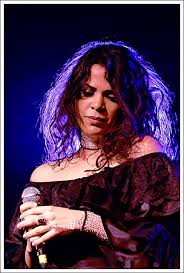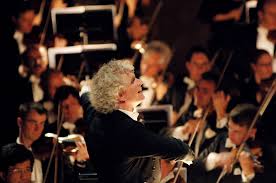To the gentle strumming of the guitar and the strains of the flute, Yasmin Levy, dressed in black and the ever enticing enchantress, cast a spell on the audience with her tremor-filled “La Serena”. It was just a start.

Firstly,a lil more about the Ladino music that Yasmin Levy sings. In her rendition, she maintains the original lyrics and melody of the songs (some of them nearly 500 years old), but changes the rhythm to a Flamenco style. She also mixes Turkish, Egyptian and other Middle-eastern music in her own Spanish compositons and the result is unbelievably beautiful.
To understand the Ladino songs better, we would have to delve a little into the Ladino culture. In 1492,in an attempt to flush the land of all non-christians, the Catholic rulers, King Ferdinand and Queen Isabella issued a decree that all Jews, Gypsies and Moors (a population of Muslim peoples from Northern Africa who conquered the lands of Spain and Portugal in 711 CE) living in the Spanish kingdom were either to convert to the Catholic faith or leave the country. Thousands of Jews were exiled from their homes, and in the years that followed these Jews settled in other parts of Europe, Northern Africa, and the Middle East (see the map of Jewish Migration).

The Jews from the Iberian peninsula carried their language with them and settled in the Ottoman empire. They became known as the Sephardic Jews and their language became known as Ladino.
It is no wonder that the Ladino songs are mostly about longing, love, desperation, passion and of course hope. These songs, handed down from generation to generation by mother to daughter and father to son, survived purely by word of mouth. They are based on simple themes from everyday life- like a mean mother-in-law or the unrequited love of a heartless lover. To those persecuted Jews, stripped of their lands and property and enslaved by new rulers, music must have been the only means to give vent to their melancholy, solitude, frustration and the occasional happiness. The wailing laments in the songs show this pain clearly. What is common in all these songs is the singer’s candid admission of his/her true feelings. It is such a contrast to the norm of the sophisticated upper class where emotions are best hidden and there are euphemisms, innuendos and a tendency to be emotionally aloof.
Coming back to the performance, Yasmin Levy is of those singers who have a “heart” voice- she sings with such feeling in her songs that you don’t need to know to language to appreciate the pathos or empathise for the loss. Be it the complex rhythmic phrasing or the slow vibratos, she modulates her voice so perfectly to bring out the right emotion. She is a brilliantly talented singer with a deep soulful and sensuous voice. It just doesn’t get better than that. Period.
She was accompanied on the percussion by Ishay Amir, her husband, who kept perfect rhythm. For some songs like the haunting “Mano Suave”, he played the darbouka (see pic below), a drum that is often used in music for belly dancing.

I was so thrilled by the Armenian Vardan Havanissian who played the wind instruments flute,clarinet and zurna (see pic below).

I thought was very similar to an Indian musical instrument called the nadaswaram (albeit a shorter version of it). He was just superb. His smooth flowing style with the ornamentation and variations was out of the world.
On the electric upright bass was Miles Danso from Ghana. The bass melded so well into the songs. On guitar was Yechiel Hasson, a master of Flamenco style. There were songs which had Ms Levy singing with only the guitar to accompany her. Both the artists’ amazing talents could be seen in those duets.
Unlike in Western music where ensembles play with sheet music, in this kind of music the musicians just play by memory. This is definitely harder as it needs perfect co-ordination. But this kind of setting leaves so much of room for improvisation and encourages spontaneity based on the mood of the audience and that was what we saw in the performance.
One perfect example of the amalgamation of Falmenco and Ladino was “Noches Noches”. The Flamenco genre’s staccato clap punctuating a vocal line was shown so beautifully in this one. It is such an evocative song.
“Una Ora” had Arabic music elements and would have been a great one for belly dancing, as would have been the funny song, “Mi suegra la negra”(The mean mother-in-law). You can imagine a newly-wed daughter-in-law singing this to herself, gritting her teeth, as she is doing some chores for her mother-in-law instead of being with her husband. Here’s a translation of the lyrics. Ms. Levy also showed some of her Flamenco moves here.
“My mother-in-law the evil one
Takes revenge on me.
I can no longer live with her.
She is stronger than death itself.
Soon I shall get rid her.”
The old cantina, “Adio Kerida” (Farewell,my love) was so beautiful. She had the audience singing to it. It might as well have been an metaphorical ode sung by a Jew to his native land.
My favorite of the evening was “la Alegria”. Contrary to its name (which means “happiness”), the song is about a woman who is pining for her love. It is so sad that it churns your insides and leaves you with a deep disgust for that imaginary cruel lover. The whooshing sound of the bass in this is so moving.
Yasmin Levy’s own compositions “Una Noches Mas” (a very slow moving number) and “El Amor Contigo” (a fast paced flamenco style song) were also about love. The Ladino style could be seen in her compositions as well.
That Yasmin Levy brings together musicians from so many different countries and different faiths is a testimonial to the respect the musical world has for her. May her efforts to bring people together with music bear fruits.
I was not the only one to have fallen for her music. There was an encore and Yasmin ended with a really sad Spanish song. As I was heading out, I overheard someone say, “That wasn’t fair. The last song only left me yearning for more. Wished she had sang some more.” Sigh, sigh, I defintely agree.
Krithika, [art]seen reviewer
Krithika likes to jump in puddles of water, especially when a person wearing all white walks past by











